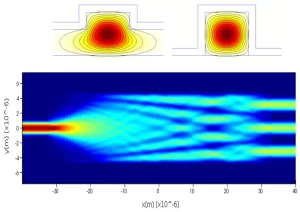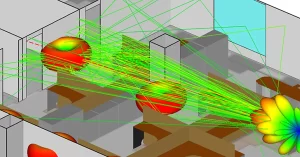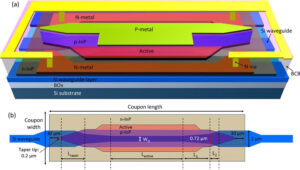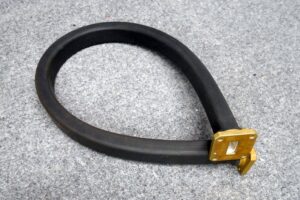Table of Contents
Light Source
The light source constitutes the basic building block of a waveguide display where the image creation process starts. The choice of a light source is closely related to the display’s energy efficiency, operational cost, and image quality. The most common options for a light source include at Micro-LEDs and OLEDs, both of which offer high brightness and a wide range of color contrast. With the technology, brightness reaches over 10,000 nits, which is a paramount characteristic in AR use of waveguide displays since it allows users to see the digital objects in direct sunlight. By contrast, while OLEDs feature perfect color contrast and an extended color range, with true blacks, the best the technology can achieve in terms of brightness is 1,000 nits, which makes the technology unsuitable for outside use.
Still, inside use is not less important because, while a device is still AR, the environment must necessarily be illuminated. In particular, the power consumption characteristics of the light source drive the battery life of portable AR devices. According to the industry data obtained in the study, the light consumption of Micro-LEDs is 10% less than the light consumption of an equivalent OLED, while rendering the same brightness. As a result, this quality ensures long battery life and, consequently, increased operational flexibility, which is important in highly professional settings such as surgeon work or field repair when AR is used on routine basis.
However, the cost is not less important because the cost of production of Micro-LEDs is substantially higher than that of an OLED. The gap between the cost of production of the two types of displays is mainly due to the complexity of the process through which tiny LEDs are produced and transferred to a display substrate. Nevertheless, as manufacturing capacities upgrade and expand, the cost of Micro-LEDs is expected to decrease. In terms of the lifespan of the light source, the LEDs will generally last longer than OLEDs. In particular, while the average lifespan of a Micro-LED is placed beyond 100,000 hours, an OLED has a lifespan of up to 1,000 hours. As a result, the use of a Micro-LED light source drives lower total ownership costs for a device with a waveguide display, intent on decreasing the frequency of the need for display replacements.
Input Coupler
The role of an input coupler in waveguides displays is crucial because it is responsible for guiding the light from the source into the waveguide accurately and in a controlled way. This component uses DOEs or HOEs to make the light do exactly what it should, entering the waveguide at an angle suitable for total internal reflection. The quality of these couplers is defined by their performance, or the ability to minimize optical losses. Thanks to high-quality DOEs, modern couplers can achieve a coupling efficiency of up to 90%, meaning that the source’s light will be directed into the waveguide in the best way possible. This feature becomes especially important in AR since both professional and consumer applications must be battery-operated, making the efficiency of energy use critical for prolonging the life of the battery.
These advances in performance, result in higher costs that are determined by the specifics of manufacturing intricate designs of DOEs and HOEs. While these costs are becoming relatively higher even for professional applications, other costs might be dwarfed by the increase in performance because it directly affects the clarity of display and thus the battery life in terms of consumer acceptance of the technology. At the same time, the price difference is not uniform, and different models of input couplers will differ in complexity of optical design and used materials.
Moreover, it is important to develop input couplers that are compatible with the varying display sizes and resolutions, which can also affect the price. The image quality always depends on the accuracy of couplers, and designing them requires precision. A good input coupler boasts not only efficiency and brightness but also very low ghosting and other typical artifacts that can reduce the quality of displayed image and the willingness of the customer to use the AR device. Finally, the modern approach allowed for an input coupler’s creation that is very thin and durable, which is critical for consumer applications and AR in everyday life.
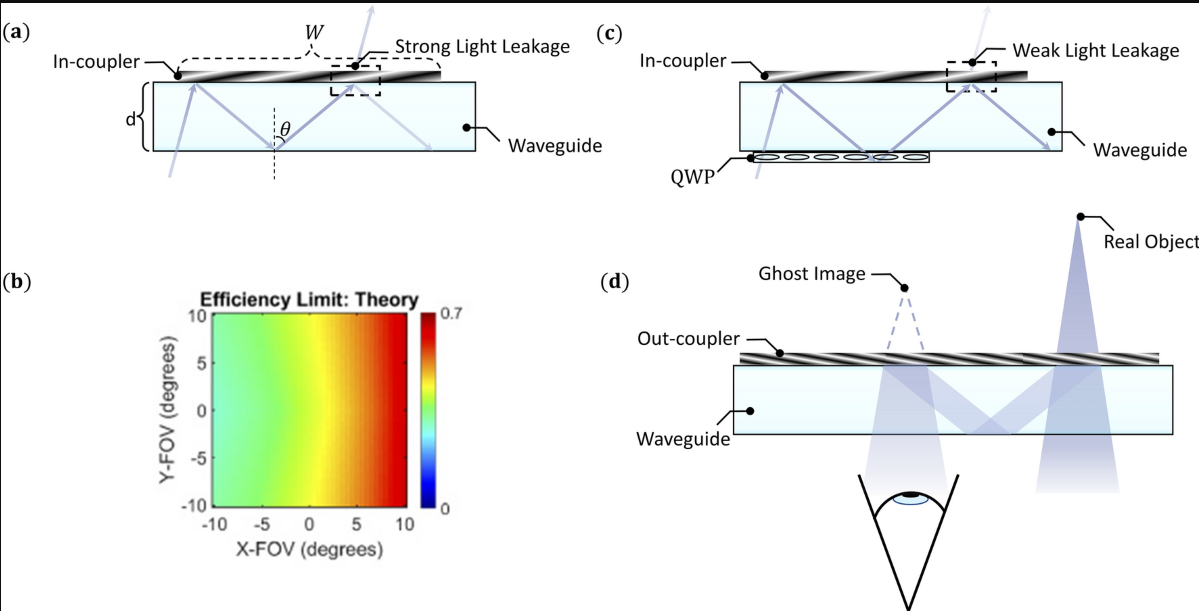
Waveguide
The role of the waveguide The waveguide is one of the central elements of a display system based on this technology, as it is the medium through which the light travels from input to output. Its design is critical to the efficiency, clarity, and practicality of the augmented reality experience. Typically, it is made from some transparent material, such as glass or clear plastics, which is optical clear and durable. The main concept that helps the waveguide do its job is total internal reflection. When light is incident on the interface of the waveguide material at an angle greater than the critical angle, it is all reflected back to the material, and none of it crosses the interface. This design ensures that the light makes it through the waveguide without any significant losses, which maintains the intensity and clarity of the display.
Thickness and weight From the practical standpoint, the thickness of the waveguide is one of its most critical qualities. Ideally, a waveguide should be thin and lightweight, ensuring that it does not interfere with the user experience. One of the most significant design goals of the current generation of AR devices is to create waveguides that are as effective at managing light while being as small in size and weight as possible. Modern waveguides are a few millimeters thick, extremely small compared to the bulky models that used to be much thicker not too long ago. For example, recent innovative designs have reduced the thickness of waveguides by about 30% in the last few years, while maintaining the efficiency of about 85-90% of light transmission. Grades of materials One of the critical choices in waveguide design is the material used to make it.
The cost is, of course, a factor, but the most important consideration is its performance as a way to guide light. High-quality optical glass is the most expensive material but offers the best performance in terms of light transmission and durability. On the other hand, some forms of plastic can be very cheap, though they may not have the same optical properties, presenting issues such as clarity. The manufacturer must balance these factors according to their desired market and goals of use. Durability is an extremely important factor in the choice of material, as the AR devices see a wide range of use, from the relatively benign conditions of consumer use to industrial settings where it may be exposed to dirt, impacts, and other sources of wear and scratching. Advances in material science have led to the invention of materials that are significantly more durable and scratch-resistant.
Output Coupler
In a waveguide display, an output coupler is the component responsible for redirecting the light that has been channeled through the waveguide towards the user’s eye. As such, it is a crucial element of any augmented reality device, as it greatly impacts the brightness, clarity, and field of view of the displayed image. Output couplers frequently use diffractive optical elements or holographic optical elements to tightly control the direction, and if necessary, the degree of spread of the light coming out of the waveguide. Thus, the efficiency of the output coupler is the factor directly influencing the quality of the visual experience enabled by the AR display.
One of the measurable characteristics of the quality of an output coupler is its light extraction efficiency. Values of around 80-90% lethal are not uncommon amongst high-quality output couplers, and this indicates that the coupler transmits up to 90% of the light that has been delivered to the user, effectively shaping brightness and clarity of the projected image. This feature is particularly important in certain uses of AR, such as training simulations in surgery and machine operation, where precise image overlaps are necessary to provide accurate guidance. In these cases, the visual clarity of the output coupler directly determines how well the digital image is merged with the real-world image. Durability and the bulkiness of the output coupler also play a role in determining the final usability of the AR device, but they are typically not the most important factor.
The choice of material for the output coupler is a crucial decision from both a cost and a performance perspective. While the most effective materials for input coupler fabrication are often the exotic ones used for laboratory purposes, in mass-manufactured products, the cost of materials plays a much higher role. As a general rule, the more durable and optically pure material will tend to perform better but also be significantly more expensive. Advances in material science have made this less of a concern, as there now exist cost-affordable materials that offer an impressive balance of performance and durability. For the output coupler, one of the more important advances has been the development of a more durable material, as replacements can be a signification factor in AR device lifespan to certain degree, especially in consumer-level products.
Viewing the Image
The viewing of the image is the final and most critical step in the operation of a waveguide display, where the projected light creates a virtual image that blends seamlessly with the real world. This operation determines the user’s entire experience with the device by affecting the perceived quality of the image and its realism integrated into the world. Thus, it is simultaneously the most significant for understanding the context in which the discussed AR device is used. The primary aspect of the image that influences the perceived quality is its resolution. It is the paramount importance for achieving high performative results for assembly or training application, where the detail that can be observed is directly linked to the quality of the operation. For example, a high-end AR device is capable of projection at up to 1080p per eye, which is a level of quality that allows for minute details. Brightness and contrast are similarly significant, affecting how well the virtual images can be seen in reality.
The device’s capability to produce 1000 nits of brightness ensures that the image is clearly visible even in broad daylight, which is a crucial requirement for an application that may serve as a navigation aid in a vehicle or a mobile virtual tourism guide. And the contrast ratio that surpasses 100,000:1 in some higher-end OLED displays ensures that the image will have a level of depth to it, with deep blacks and vibrant colors. The final, and potentially most critical aspect of the viewing part of the operation is the field of view. Wider FOV is crucial for creating a more immersive virtual reality experience, and it needs to be taken into the final consideration.
In the case of AR devices, FOV typically ranges from about 30 to 50 degrees diagonally, but newer technologies expand these constraints, with some new devices striving for up to 100-degree FOV, which they argue allows them to match the human field of vision. And the last, the connecting factor of these concerns is usability, in the context of how long the users can feasibly wear the device in practice. Most of these issues, such as ergonomic design, as lightweight, and balanced weight distribution, allow for the continuous wearing of the devices by the users. It is vital for the application of the devices in the entertainment and education context, as the users will potentially wear them for a few hours at once.

